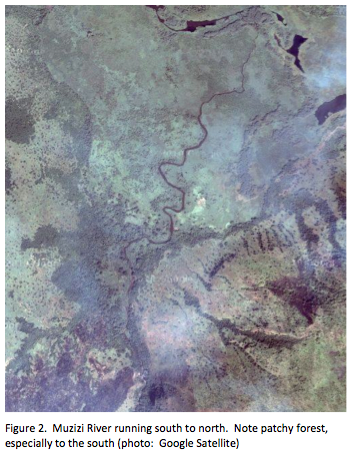Muzizi Community
 The Muzizi River marks the eastern half of the northern boundary of the reserve, and as such the forest flanking the northern bank of the river is outside the reserve, while the southern half in inside. The southern banks of the Muzizi are on the side of the river closest to the fishing village of Ntoroko, and the point where the Muzizi meets Lake Albert is literally only hundreds of meters from Ntoroko. Ntoroko grew steadily in the 90s, and much faster in the 2000s. With such growth inevitably natural resources nearby are strained. In 1996 and 1997 Prof. Hunt visited the Muzizi River forest several times and heard pant-hoots and saw chimpanzee sleeping nests. At that time some areas were completed deforested by illegal logging, but other areas were less seriously degraded, and still other areas appeared to be relatively undisturbed. Over the next few years much of the forest on the northern bank of the Muzizi was logged. Charcoal was sold in abundance on roads nearby, presumably made from wood logged in the Muzizi forest.
The Muzizi River marks the eastern half of the northern boundary of the reserve, and as such the forest flanking the northern bank of the river is outside the reserve, while the southern half in inside. The southern banks of the Muzizi are on the side of the river closest to the fishing village of Ntoroko, and the point where the Muzizi meets Lake Albert is literally only hundreds of meters from Ntoroko. Ntoroko grew steadily in the 90s, and much faster in the 2000s. With such growth inevitably natural resources nearby are strained. In 1996 and 1997 Prof. Hunt visited the Muzizi River forest several times and heard pant-hoots and saw chimpanzee sleeping nests. At that time some areas were completed deforested by illegal logging, but other areas were less seriously degraded, and still other areas appeared to be relatively undisturbed. Over the next few years much of the forest on the northern bank of the Muzizi was logged. Charcoal was sold in abundance on roads nearby, presumably made from wood logged in the Muzizi forest.
Chimpanzees can live in degraded forest—both of the other dry-habitat chimpanzee sites are in areas with human occupation—so even with perhaps half of the habitat destroyed, chimpanzees were still hanging on in the late 90’s. In 2008 SCP assistant Tim Webster visited the Muzizi forest to check on the status of the community there for the first time since Prof. Hunt had visited in 1999. Webster reported that the forest was completely gone. Satellite imagery from 2011 shows that some forest remains, some within 100s of meters of bare areas. Chimpanzees could certainly live in reduced numbers in the area, and the forest could make a recovery if it were properly managed.

